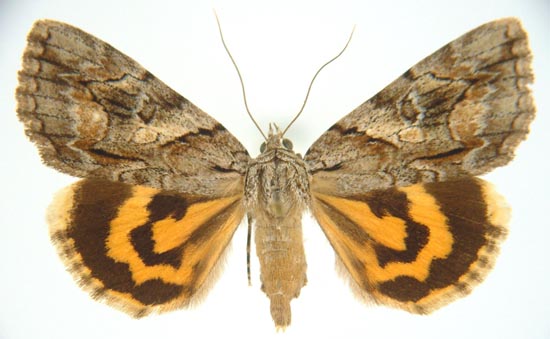


|
Richard Wolfert of New Jersey asked permission to use the drawing above and I consented. He then remarked that many Catocala are photographed in a resting pose and sent me back the following re-labelled and re-oriented diagram (an excellent idea) for display on this site:

In my descriptions I refer to wing edges, areas, lines, spots, markings, etc. on the wings of these moths.
The upper edge of the forewing, running from the thorax (body) to the wing tip (apex) is called the costa. The wing edge running from the apex to the anal angle is called the outer margin. The wing edge running from the anal angle to the body is called the inner margin.
In the forewing, the pink region close to the body is the basal area. It is separated from the pale green median area by the antemedian line. This antemedian line may be thick or thin, distinct or indistinct, single or double. Its shape is usually consistent within a species.
Another line, the postmedian line, separates the pale green median area from the pale brown subterminal area. This postmedian line may be thick or thin, distinct or indistinct, single or double. Its shape is usually consistent within a species. I refer to the two upper most projections of this line, toward the outer margin, as teeth. In some species they are quite thin and elongate, giving them a very sharp appearance. In other species the upper teeth may be considerable shorter and blunter. Lower teeth are practically non-existent in some species, but quite prevalent in others.
A third line, often much less distinct, more diffuse, is called the subterminal line. It divides the pale brown subterminal area from the pale blue terminal area. Often there are dashes (thin dark lines), bars (thicker, longer lines), and/or dark arcs in any or many of these areas.
Almost all Catocala have two distinct spots in the forewing median (middle) area. The upper marking, closest to the costa, is called the reniform spot (RS). It may be large or small, single walled or double walled. The lower marking is called the subreniform spot (SRS). It may be large or small and may have a characteristic shape. I refer to this spot as being "open" when it is shaped like a pork chop with an elongated "handle" interrupting the post median line.

Catocala retecta, Stillwater Township, Sussex County,
New Jersey,
August 2, 2006, courtesy of Joe Garris.
The black antemedian line is prominent and is inwardly, narrowly lined with greyish white and then duplicated by a thinner black line. A basal black dash runs from the body to the center of the antemedian line, and then continues into the median area to the base of the open subreniform spot.
Note the light coloured, elongated and open subreniform spot which breaks the postmedian line. The center of the upper reniform spot is kidney-shaped and brown, outlined in black, then grey, then black again.
The two upper teeth of the pm line are elongate and dark-tipped. Subsequent teeth are shorter yet still prominent and dark tipped. There is a large wide tooth, underlined with a distinct black dash, below the interruption by the subreniform spot.
The subterminal area shows some brown scaling, becoming almost white as it meets the diffuse subterminal line. The terminal area is brownish-grey with wing veins accentuated with black just below the apex. The vein running below the subreniform spot is also accentuated with black in the subterminal area.
The off-white (bright in fresh individuals) hindwing fringe is only lightly checked along the wing veins.
For the black underwings, the colour and degree of checking of the hindwing fringe is often a good determiner for identification.
For the "coloured" underwings, the hind wing median band (grey in my diagram) often has a distinct shape. In some of the smaller underwings it makes a loop back to the hindwing costa, paralleling the hw inner margin. In some species it terminates at the inner margin, while in other species it is truncated before reaching the inner margin.
The outer black band or terminal band may also have a distinct shape and width.
Colouration and degree of checking of the hindwing fringe are usually consistent within a species.

The kidney shaped reniform spot is brown, outlined in black, often with white scaling on its outward side with black veins projecting into the extension caused by the upper tooth of the pm line. The second tooth is often reduced, and subsequent teeth are almost eliminated in a smooth arc until the black-underlined lower large tooth. The region below this black subterminal dash is dark brown to darker grey down to the inner margin.
The light grey-brown subreniform spot is closed, relatively large, and faintly outlined in black.
In the subterminal area, there is a strong presence of brown scales, turning to greyish white at the weak but distinct subterminal line.
The relatively thin and irregular black median band on the orange-yellow hindwing makes a complete loop. Some weak black scaling follows the inner margin from the remanants of the uninterrupted outer black band at the anal angle. The orange fringe is strongly checked.
The Catocala mira image below from Windsor, Ontario, courtesy of Maurice Bottos shows the same features as the specimen above from Louisiana.

Good luck, even with carefully worded descriptions and images, identifications can be tricky for this genus.
The first groups are for species which have been taken in or east of Texas as well as in states and provinces northward.
As of October, only yellow, pink and black are ready.
Return to Main Catocala Index
This page is brought to you by Bill Oehlke and the WLSS. Pages are on space rented from Bizland (2008 rental fee is slightly over $100.00/year). If you would like to become a "Patron of the Sphingidae/Catocala Sites", contact Bill.
Please send sightings/images to Bill. I will do my best to respond to requests for identification help.